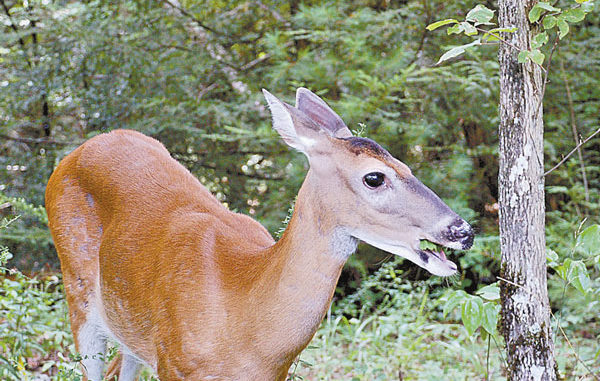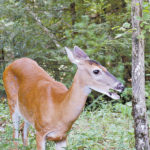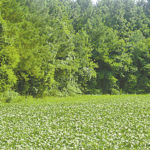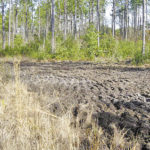
The major planting season in the Carolinas for warm-season food plots generally is April through early May. But unlike other warm-season plantings, March provides ideal conditions to establish a protein-rich stand of chicory that will be adored by deer and other wildlife species.
First discovered by the ancient Egyptians as a coffee substitute, common chicory — Cichorium intybus, aka coffee weed — offers wildlife a palatable, rich food source capable of withstanding extreme conditions in the South.
Over the last decade, many major seed companies began to add chicory into their spring and fall food-plot mixes after the discovery of its unique and beneficial attributes. Chicory continues to receive more attention every year from the public, which is realizing its perennial power as a prime food-plot forage species.
First of all, deer just love it! Chicory is over 95-percent digestible, with a third of its composition being digestible protein. Deer will forage on chicory without hesitation and will seek out areas where it’s established. Deer, turkeys and many other species of wildlife will appreciate its nutrient-rich, leafy greens available all 12 months.
Chicory is a unique herb with the ability to withstand the South’s variable climate conditions, making it an ideal perennial food source in the Carolinas. While many food-plot seeds are available, chicory is a special addition with many merits and should be a part of the overall food-plot plan.
Chicory is a perennial herb with a deep tap root that prefers well-drained sites and can tolerate acidic soil conditions. Most soils throughout the Carolinas are highly acidic, offering acceptable conditions for germination and establishment. After establishment, chicory’s deep, carbohydrate-rich tap root enables it to withstand long periods of drought on well-drained sites. While periods of hot and dry conditions prevail during Carolina summers, chicory is hard-wired to survive.
Food plots on well-drained, sandy sites often discourage wildlife managers from routine plot failures with other less-tolerant seed mixtures. Chicory’s deep tap root will take hold on these sandy sites, offering success and converting these sites into production. Not only will chicory survive the extreme summer conditions, it will continue to produce palatable forage all summer long, when many other perennial plantings decline.
Chicory has a unique characteristic preferred by wildlife managers. Competition among weeds often keeps food plots from success and eventually chokes them out. Just as with many other exotic species, chicory has some invasive characteristics, including rapid growth, and it will out-compete most weeds, eliminating them as a threat to survival. However, weeds will choke out chicory during early establishment. Weeds should be controlled before planting to yield the best results.
Fortunately for land managers, chicory is a perennial herb and only requires seasonal maintenance to continue its rate of production. Deer forage on the leafy greens just above the surface of the soil. In early summer, chicory food plots will sprout large, un-nutritious flowering stems extending from one to six feet in height. When plants begin to vigorously grow these flowering stalks, the stand should be mowed. Production of the flowering stalks channels available energy to reproduction and slows forage production. The periodic mowing will discourage the reproductive process and will redirect nutrients to forage production, improving the available foods for wildlife. Plots should be mowed every 30 to 60 days for optimal growth and forage production.
Even though chicory can withstand acidic soils down to a pH of 4.5, slightly-acidic to neutral soil pH is ideal for optimum growth. Therefore, lime treatments are recommended before or during planting to aid in germination, initial growth and establishment.
Chicory’s vigorous growth characteristics will utilize all available nutrients within the soil and as they become available, especially with nitrogen. Before planting, a balanced fertilizer treatment is recommended to condition the soil for chicory growth, such as 19-19-19 at 200 to 300 pounds per acre. After establishment and periods of heavy growth/foraging, supplemental nitrogen can be applied to prolong rate of growth.
Chicory prefers moderate to full sunlight. Seeds can be planted using a cultipacker or can be broadcast over a well-prepared, even seed bed. Seeds are very small and should not be covered any more than a quarter-inch, but an eighth-inch is recommended for optimum germination and growth. Seeds should be planted at a rate of three to four pounds per acre if planted alone. In areas of expected heavy foraging, rye can be planted along with the chicory to sustain foraging requirements.
Even though chicory has been around since discovery of the New World, its re-birth into managed food plots will provide deer and other wildlife with a sustainable food source for most of the year. Chicorys deep history in Old and New World areas has once again found another place in society — to be used by native wildlife as a highly digestible protein source.
Jeff Burleson is a native of Lumberton, N.C., who lives in Myrtle Beach, S.C. He graduated from N.C. State University with a degree in Fisheries and Wildlife Sciences and is a biologist and registered professional forester in North Carolina and South Carolina for The Brigman Company.
Supplement chicory with legumes
Early spring plantings offer deer and other wildlife with a warm-season food source critical during fawn rearing and the antler growth period. Chicory is one of the best food-plot seeds available for well-drained sites under full sun conditions, but it requires high levels of nitrogen to sustain rapid growth rate of protein-rich forage. Combining legumes with chicory plantings will offer these two species in a symbiotic relationship for sustainable growth.
Without a natural source, nitrogen supplements are required throughout the year to sustain rapid growth of forage material in stands of chicory. Legumes, such as clovers, peas and beans are nitrogen-fixating species. Legumes harbor nitrogen-fixating bacteria within their tissues. These unique bacteria convert atmospheric nitrogen into usable nitrogen to become available for uptake by chicory and other plant species.
Fortunately, alyce clover also prefers moderate to well-drained sites and can be planted as a companion species to chicory. This legume holds up well to heavy browsing and is an important spring and summer food for deer and other species of wildlife. Alyce clover provides deer with forage containing nearly 15-percent usable protein. When these two species are planted together, use a phosphorus-heavy fertilizer before planting and throughout the summer as needed. Chicory’s nitrogen requirements will be fulfilled by the companion seed shortly after alyce cover’s establishment.
Other legumes can be over seeded into existing stands of chicory during optimal times for planting. For instance, white and red clovers can be overseeded and broadcast in the fall. Incorporating legume species into the initial planting mix or after establishment will be well received by chicory to provide a natural nitrogen source for sustained growth.
Strip discing for toms
Springtime is almost here, with just a few weeks of official winter remaining. The long-awaited turkey season is upon us, but a few more habitat-manipulation techniques may be left to accomplish that will give hunters the best odds for luring a tom into shotgun range.
Spring is a time of beginnings, with the arrival of neo-tropical migrants, fresh new leaves and the turkey breeding season, which begins in early March and continues for six to eight weeks. Breeding behavior solicits a wide variety of preferred habitats. Improving these habitats will increase the potential for frequent use by wild turkeys.
Essentially, tom and hen turkeys frequent similar areas for feeding and to practice courting behavior, and they will gravitate to fields and open wooded areas to court. Since turkeys attract mates by vocalization and a visual means, open areas give them the opportunity for their calls to be heard from great distances and to be spotted from across the field. These open areas along fields and travel corridors are primary use areas subject to habitat manipulation.
For starters, open areas should have remnant cool-season food plots or be contained within active agriculture with a dressing of winter wheat covering the landscape. Turkeys consume both vegetable and insect matter throughout the year. Grazing areas provide both of these food sources. Either way, there areas offer prime conditions for enticing spring breeding behaviors.
However, these open fields or open areas need adequate fresh dirt to sweeten the pot. Freshly-exposed soil releases worms and grubs for turkeys to eat. Newly-tilled soil attracts these feathered beasts — just about as well as bare grain tossed along the ground.
Strips should be tilled or disced along forest edges, woods roads, throughout agriculture fields and food plots, or areas within open forested areas typically used by turkeys for breeding rituals. Turkeys will immediately gravitate towards these tilled areas, and they can be exceptional locales to locate turkeys throughout the day in spring.







Be the first to comment